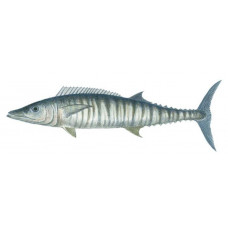Latin name
Acanthocybium solandri
Other names
Barracuda, oahu fish, ocean barracuda, Pacific kingfish, pride of Bermuda, queenfish, tigerfish; Arabic: kanaad znjebari; Creole: bécune grosse race, kin fis, thazard raité; French: paere; Hawaiian: ono; Japanese: kamasusawara; Portuguese: cavala gigante, cavala-da-India, cavala empinge; Spanish: guacho, peto, sierra; Tuvaluan: tepala.
Identification
A long, slender, cigar-shaped mackerel with a pointed head and wide forked tail, wahoo has a shiny or dark blue back color. It has 25 to 30 bright or dusky blue vertical stripes, or "tiger stripes," that stretch down its bright silvery or silvery gray sides and sometimes join in pairs below. A distinctive feature is the mobile upper jaw, which has 45 to 64 teeth, of which 32-50 are on the lower jaw. The lateral line is well-defined, dropping considerably in the middle of the first dorsal fin and extending in a wavy line back to the tail. The first dorsal fin is long and low and has 21 to 27 spines. It is separated from the second dorsal fin, which has 13–15 rays. The anal fin has 12-14 small rays. There is a row of 9 dorsal fins, both above and below the caudal fin. Gill filaments are fused. Lateral line is not branched. Swim bladder is present.
Distribution
In North America, wahoo inhabit tropical and subtropical waters of the Atlantic and Pacific Oceans. Seasonal aggregations are observed off the Pacific coast of Panama, Costa Rica and Baja California, off Grand Cayman Island, and off the western Bahamas and Bermuda.
Habitat
Marine epipelagic fish. This species lives in coastal and open waters of the tropical and subtropical zones of the World Ocean. Constantly occurs in the western part of the Atlantic Ocean - in the Gulf of Mexico and the Caribbean Sea, making seasonal migrations within this area. In the eastern Atlantic meets off the west coast of Africa, in the Mediterranean Sea, in the Indian Ocean - along the eastern shores of Africa, in the Arabian Sea, along the coast of Hindustan, near the island of Ceylon, in the Indo-Malayan Archipelago. In the Pacific Ocean - south of Honshu and Korea, including the waters of the islands of Taiwan, Ryukyu, Solomon, Marquesas, Hawaii, in the eastern part of the ocean - from the Gulf of California to Ecuador.
Size
Wahoo, grow so fast that both sexes reach sexual maturity within the first year of life. Their average weight is 10 to 30 pounds, and they are 4 to 5 feet long. The maximum size is 7 feet and over 180 pounds. The world record in tackle is considered to be a 158 pound, 8 ounce fish caught in 1996 off the coast of Baja California, Mexico.
Life history and Behavior
Makes seasonal migrations.
Food and feeding habits
Wahoo feed on pelagic species such as porcupinefish, flyingfish, herring, pilchards, scad, lanternfish, small mackerel and tuna, and squid.
Reproduction
Spawning has been observed in the Pacific Ocean, near the Ogasawara Islands (Japan), and in the Atlantic Ocean, near the Cape Verde and Dakar Islands. Reproduces apparently throughout the year. Fertility is high: a 131-cm female has about 6 million eggs.
| Classification | |
| Phylum | Chordata |
| Class | Actinopterygii |
| Squad | Scombriformes |
| Family | Scombridae |
| Genus | Acanthocybium |
| Species | A. solandri |
| Features | |
| Conservation status | Least Concern |
| Habitat | Pelagic |
| Life span, years | No information |
| Maximum body weight, kg | 83 |
| Maximum length, cm | 250 |
| Sailing speed, m/s | No information |
| Threat to people | Edible |
| Way of eating | Predator |
Wahoo
Tags: Wahoo


